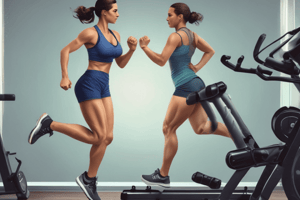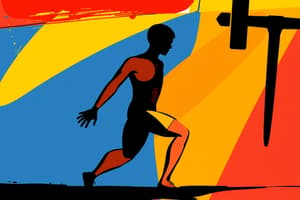Podcast
Questions and Answers
What is the primary purpose of evaluating the sport in the initial stages of programme design?
What is the primary purpose of evaluating the sport in the initial stages of programme design?
- To determine the energy systems required for the sport (correct)
- To assess the athlete's injury history
- To understand the athlete's goals and needs
- To develop a training programme
What is the principle of training that states that the training programme should be tailored to the individual athlete's strengths and weaknesses?
What is the principle of training that states that the training programme should be tailored to the individual athlete's strengths and weaknesses?
- Specificity
- Overload
- Recovery
- Individuality (correct)
What is the phase of acceleration where the athlete reaches maximum velocity?
What is the phase of acceleration where the athlete reaches maximum velocity?
- Maximus velocity phase (correct)
- First step quickness
- Acceleration phase
- Speed endurance phase
What is the most modifiable factor affecting speed?
What is the most modifiable factor affecting speed?
What is the primary focus of the tertiary phase of speed development?
What is the primary focus of the tertiary phase of speed development?
What is the definition of agility in the context of speed and agility training?
What is the definition of agility in the context of speed and agility training?
What is the purpose of the maintenance phase of programme design?
What is the purpose of the maintenance phase of programme design?
What is the term for the rate of change of velocity?
What is the term for the rate of change of velocity?
What is the primary goal of periodisation in a training program?
What is the primary goal of periodisation in a training program?
What is the purpose of ballistic training?
What is the purpose of ballistic training?
What is the recommended load for power training?
What is the recommended load for power training?
What is the relationship between force and velocity?
What is the relationship between force and velocity?
What is the purpose of plyometric training?
What is the purpose of plyometric training?
What is the concept behind plyometric training?
What is the concept behind plyometric training?
What is the normal percentage difference between squat jump and countermovement jump?
What is the normal percentage difference between squat jump and countermovement jump?
What is the purpose of the Golgi tendons?
What is the purpose of the Golgi tendons?
What is the primary purpose of fitness testing in the context of a training program?
What is the primary purpose of fitness testing in the context of a training program?
Which of the following is a characteristic of Type I muscle fibers?
Which of the following is a characteristic of Type I muscle fibers?
What is the effect of resistance training on muscle fibers?
What is the effect of resistance training on muscle fibers?
What is the primary factor that affects the force produced by a muscle?
What is the primary factor that affects the force produced by a muscle?
What is the role of connective tissue in muscle function?
What is the role of connective tissue in muscle function?
What is Repeated Sprint Ability (RSA) in the context of fitness testing?
What is Repeated Sprint Ability (RSA) in the context of fitness testing?
Which of the following is an external fitness variable?
Which of the following is an external fitness variable?
What is the term for the maximal force that a muscle or muscle group can generate at a specified velocity?
What is the term for the maximal force that a muscle or muscle group can generate at a specified velocity?
Flashcards are hidden until you start studying
Study Notes
Fitness Testing and RSA
- Fitness components include Cardio-respiratory endurance (VO2 Max), Musculoskeletal fitness, Muscular strength, Muscular Power, Muscular endurance, Flexibility, Body Weight, and Body composition.
- Fitness variables can be classified into internal (Age, gender, genetics, mental state, health) and external (Environment, equipment, time, work, and lifestyle demands) factors.
- Fitness testing helps measure progress and health, identify areas for improvement, and develop training programs.
- RSA (Repeated Sprint Ability) is the ability to maintain sprint performance over varying periods of time, requiring high aerobic fitness.
Strength
- Strength is the maximal force that a muscle or muscle group can generate at a specified velocity.
- Resistance training can increase muscle cross-sectional area and myofibrillar size and number, leading to strength improvements.
- Muscle fibers have different colors due to varying levels of oxidation, with Type I being slow and aerobic, and Type II being fast and anaerobic.
- Actin-myosin cross-bridge attachments are strong at different angles, and connective tissue makes muscles stronger eccentrically.
Loads and Frequencies
- Hypertrophy (muscle growth) training: 60-80% load, 8-12 reps, 3-20 sets, 30-90s rest.
- Strength training: 85-100% load, 1-6 reps, 4-10 sets, 3-5 min rest.
- Max 1RM calculation: (Poliquin, 1986) = 80% load divided by reps value found in table x 100.
Power
- Power is the ability of muscles to produce high levels of mechanical work quickly.
- Power = Force (strength) x Velocity (speed).
- Force = Mass x Acceleration.
- Inverse relationship between force and velocity.
- Golgi tendons stop the body when there is too much force.
Training Techniques
- Ballistic training involves projecting a load rather than holding it, triggering fast twitch muscle fibers.
- Plyometric training helps athletes be quicker off the mark, more powerful, and rapidly change directions.
- Plyometrics work the stretch-shortening cycle, and concentric phases can be stronger if the muscle has been stretched eccentrically prior.
Periodisation
- Periodisation is the process of adapting to changing training over time.
- Steps include: 1) evaluating the sport's needs, 2) athlete evaluation, and 3) programme design incorporating periodisation (microcycles, mesocycles, and macrocycles).
Principles of Training
- Overload: increasing load to provide stress for adaptation.
- Specificity: training that replicates the sport's needs.
- Individuality: planning individualized to athlete's strengths and weaknesses.
- Recovery: rest to allow adaptation.
- Maintenance: maintaining improvement to avoid regression.
Speed and Agility
- Speed: the ability to achieve high velocity.
- Agility: the ability to change direction rapidly and accurately.
- Acceleration: the rate of change of velocity.
- Phases of speed: first step quickness, acceleration phase, and maximum velocity phase.
- Main factors affecting speed: stride frequency, stride length, and anaerobic endurance.
- Development of speed: building from the bottom up, with primary, secondary, and tertiary development focusing on technique, assisted/resisted sprinting, and basic fitness, power, and speed endurance.
Studying That Suits You
Use AI to generate personalized quizzes and flashcards to suit your learning preferences.




